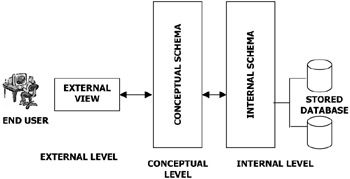2. Basic Database Concepts
2. Basic Database Concepts
A database is a logically coherent collection of related data, where data refers to known facts that can be recorded and that have implicit meaning [2]. A database management system (DBMS) is a collection of programs that enables users to create and maintain a database. Together, the database and DBMS software are called a database system. Contemporary DBMS packages have a modular design and adopt a client-server architecture. A client module, running in the user's workstation, handles user interaction and provides friendly GUIs (graphical user interfaces). The server module is responsible for data storage, access, search, and other operations.
Database systems should be designed and built in a way as to hide details of data storage from its end users. Such abstraction can be achieved using a data model, normally defined as a collection of concepts that can be used to describe the structure of a database, i.e., its data types, relationships, and constraints imposed on data. Most data models also include a set of basic operations for specifying retrievals and updates on the database. An implementation of a given data model is a physical realization on a real machine of the components of the abstract machine that together constitute that model [3].
Data models can be categorized in three main groups:
-
High-level or conceptual data models: use concepts such as entities, attributes, and relationships, which are close to the way many users perceive data.
-
Low-level or physical data models: describe details on how data is stored in a computer, which make them meaningful to computer specialists, not to end users.
-
Representational (or implementation) data models: widely used intermediate category, which aims at concepts that may be understood by end users but that are not far from the way data is organized in a computer. The most widely used representational data models are the relational data model and the object data model.
The description of a database is called the database schema, typically represented in a diagram (usually referred to as schema diagram) where each object is called a schema construct. The database schema is specified during database design and is expected to remain unchanged unless the requirements of the database applications change.
A typical architecture for a database system, proposed by the ANSI/SPARC Study Group on Database Management Systems and known as the ANSI/SPARC architecture, is shown in Figure 1.2. This architecture is divided into three levels, each of which has its own schema:
-
The internal level (also known as the physical level) has an internal schema, which describes the physical storage structure of the database.
-
The conceptual level (also known as the community logical level) has a conceptual schema, which describes the structure of the whole database for a community of users.
-
The external level (also known as the user logical level or view level) has a number of external schemas or user views. Each external schema describes the part of the database that a particular user group is interested in and hides the rest of the database from that user group.

Figure 1.2: The three levels of the ANSI/SPARC architecture.
The three-schema architecture involves mappings - represented by the double-pointed arrows - that can be updated any time a partial change in some of the database's schemas take place. The ability of changing the schema at one level of a database system without having to change the schema at the next higher level is known as data independence.
A DBMS must provide appropriate languages and interfaces for each category of users. The type of language that allows an end user to manipulate, retrieve, insert, delete, and modify data in the database is known as data manipulation language (DML). There are two main types of DMLs: high-level DMLs (such as Structured Query Language - SQL) can work on a set of records, while low-level DMLs retrieve and process one record at a time. A high-level DML used in a stand-alone interactive manner is also called a query language.
EAN: 2147483647
Pages: 393